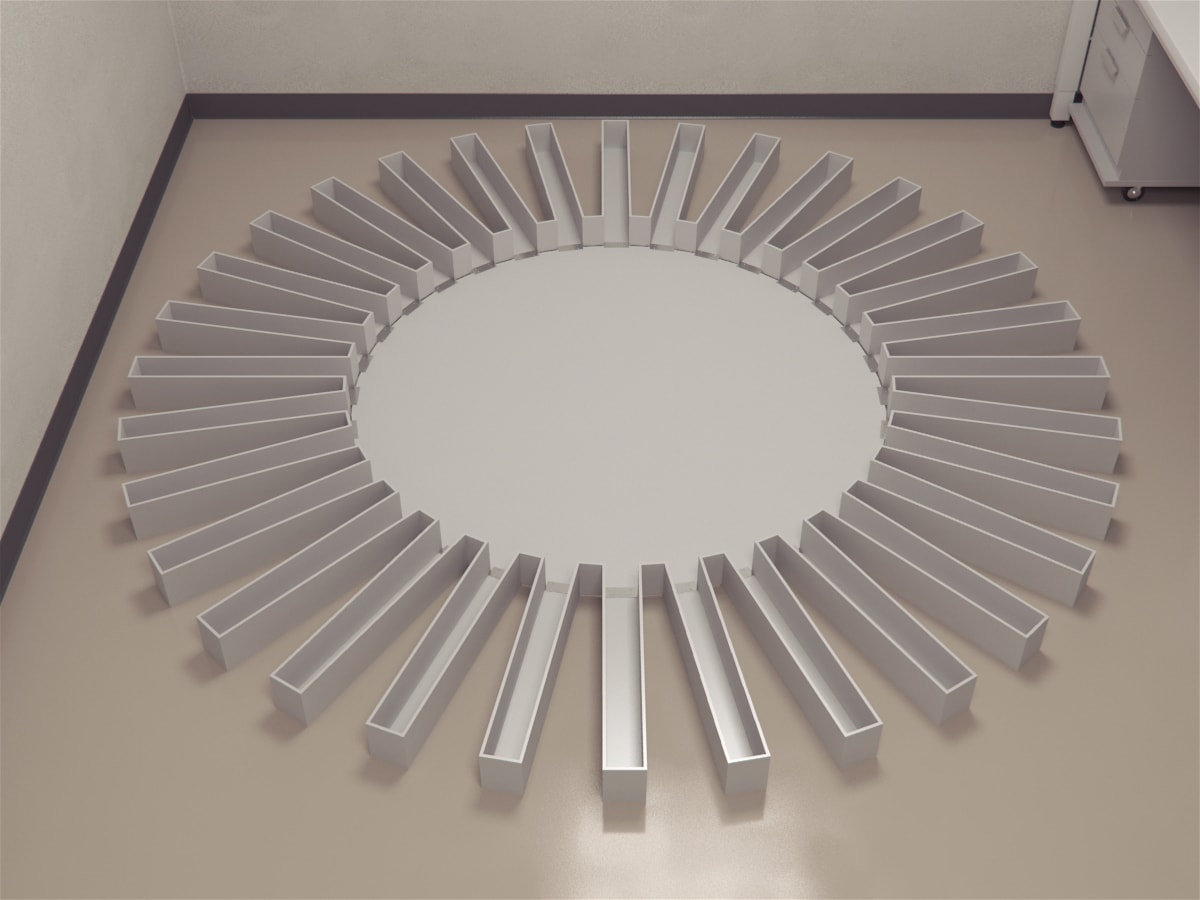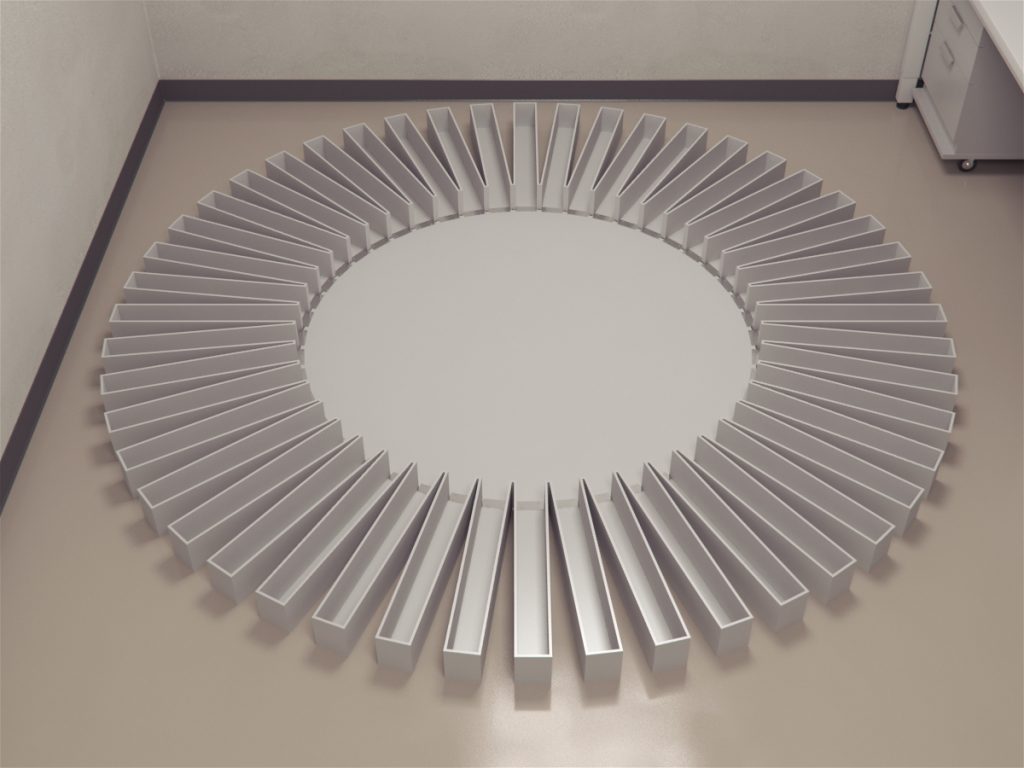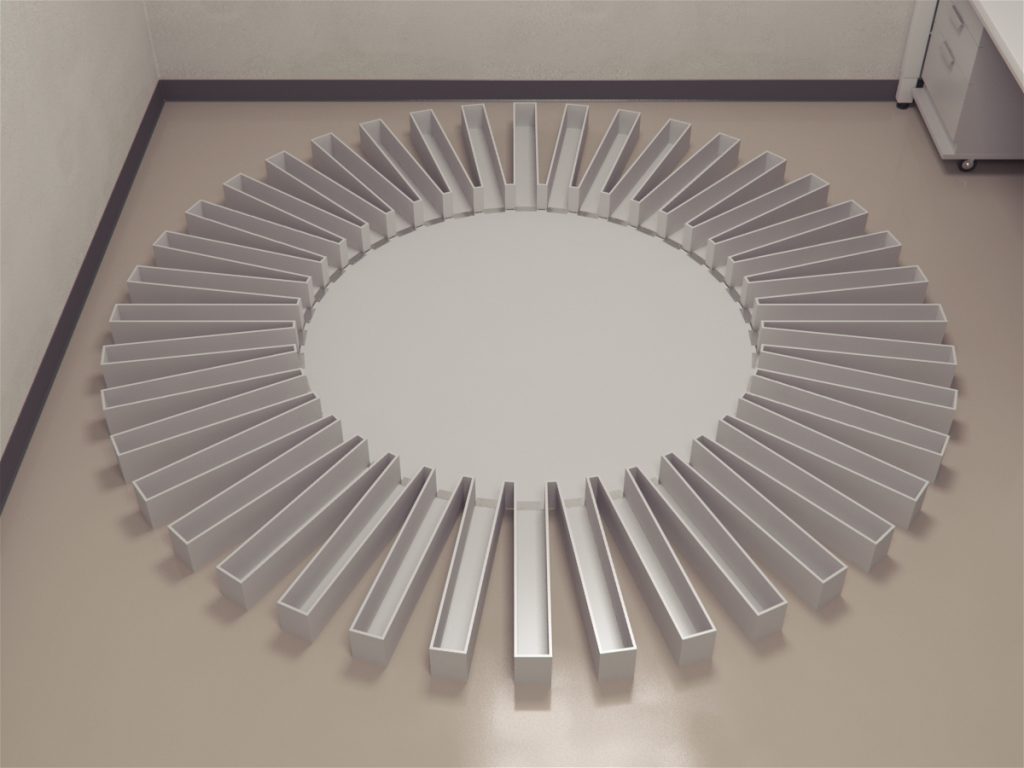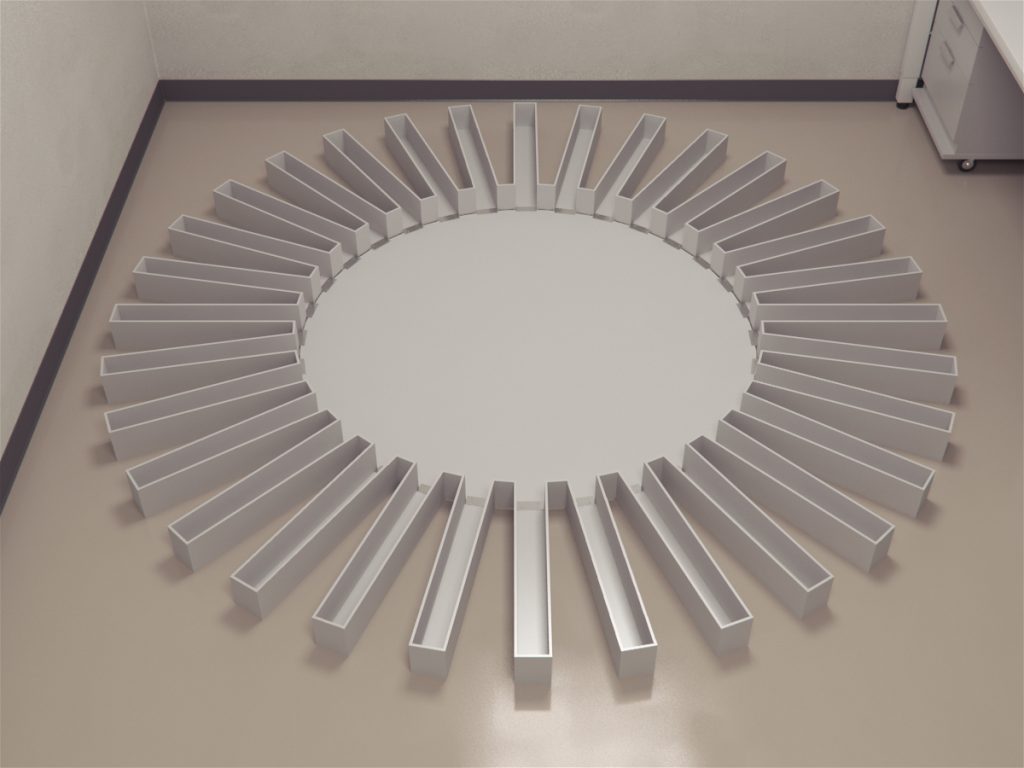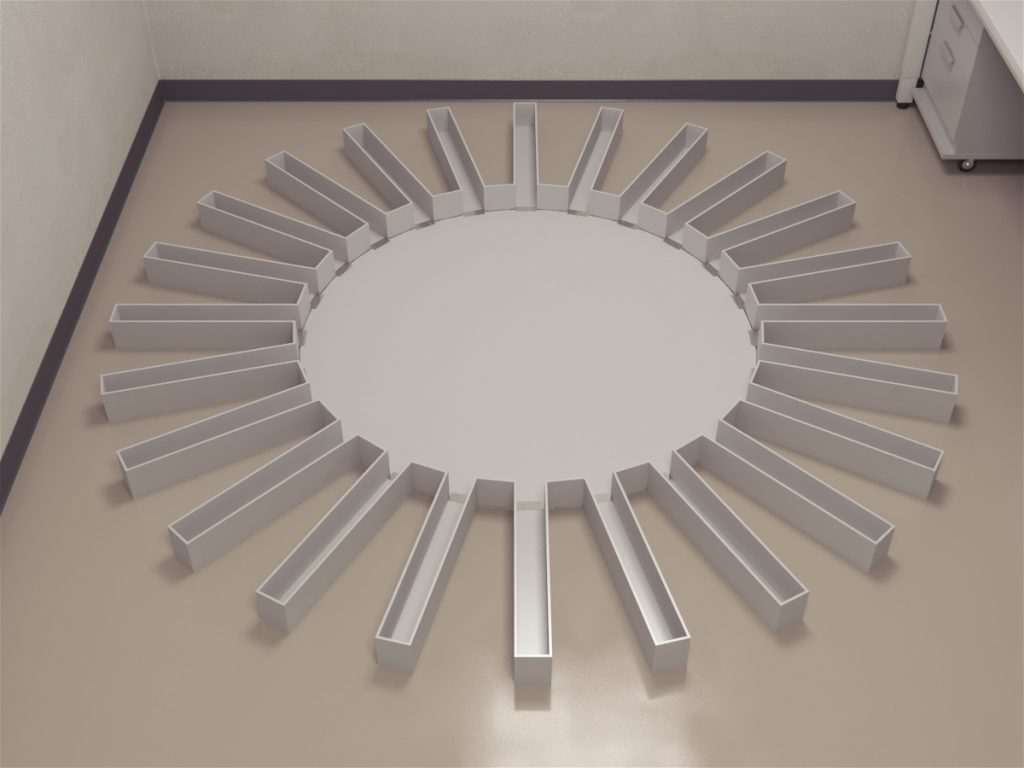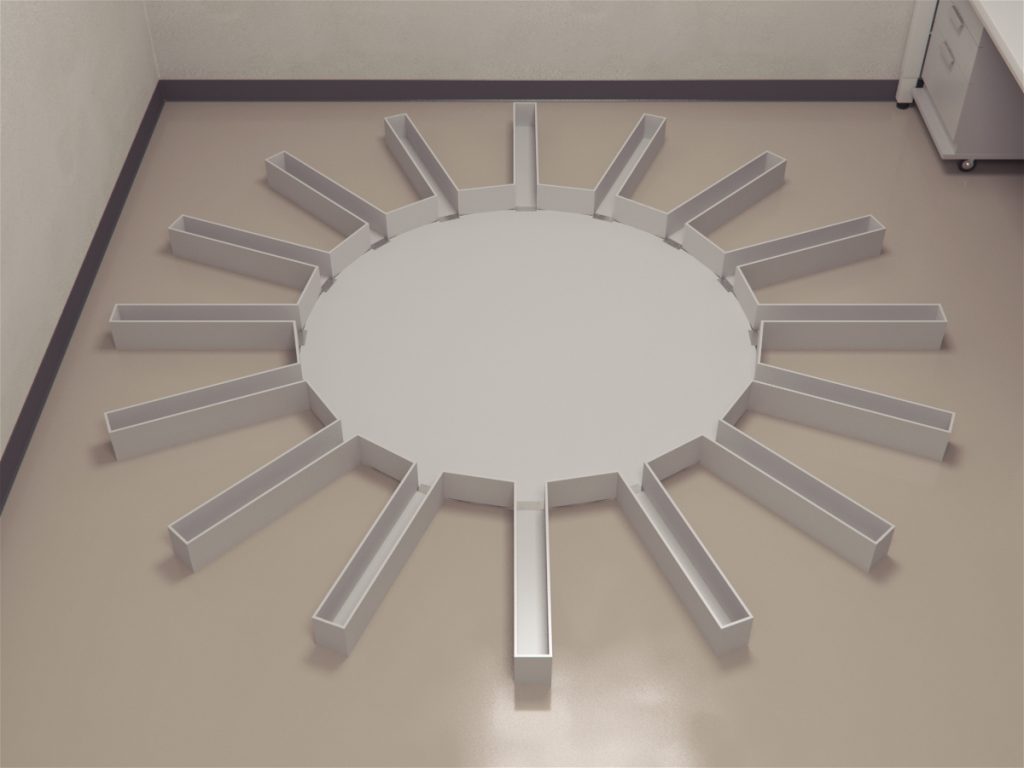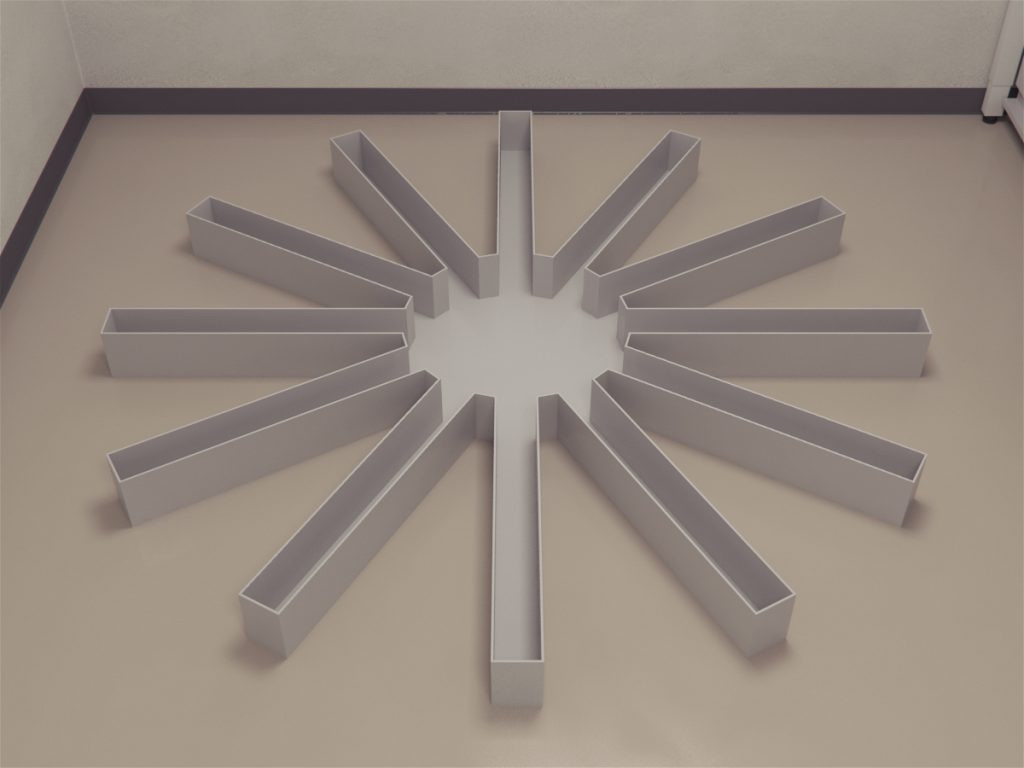Description
The Radial Arm Maze (RAM) was developed by Olton and Samuelson in 1976 to understand spatial learning and memory in rodents. Their design included a central platform with 8 arms radiating out at an equiangular distance from one another. The concept behind the maze was based on the innate exploratory drive of the rodents and their ability to remember locations when baited with food rewards. Over the years modifications have been made to the maze to meet different requirements of investigations. One such modification is increasing or decreasing the number of arms of the maze. Experiments using as few as 4 arms (also see Elevated Plus Maze), 5 arms and 6 arms exist. The larger number of arms ranging anywhere from 12 to 48 have also been used. However, the standard and most commonly used Radial Arm Maze is the 8 arms version.
Inquire
Radial Arm Maze performance in a systematically increased arms configuration
In a 2003 study by Cole and Chappell-Stephenson, the relationship between the increased number of arms in a Radial Arm Maze and the spatial memory performance of the subjects were explored. The study performed experiments starting with the standard 8-arm configuration, with the gradual addition of 8 arms until a 48-arm configuration was achieved.
Understanding of the effect of increased number of arms was done using two experiments. For both the experiments a large central platform capable of supporting a 48-arm configuration was used. In the first experiment, the arms were added at random to the platform starting with an 8-arm configuration. The random order of arm placement was used as the larger number of arms would not allow for symmetry in design. The results of this experiment showed that performance of the subjects decreased as the number of arms increased. The performance, determined as the percentage of novel entries in the first n opportunities, remained poorer than in 8-arm configuration (85.3%) starting at a 16-arm configuration (78.0%) up till the 48-arm configuration (70.1%).
Cole and Chappell-Stephenson based on their first experiment speculated if the spatial separation between the arms had a more potent role than the number of arms in influencing the performance of the subjects. For the second experiment, two types of configuration were used; spread-out and tightly clustered. The experiment and the phases of adding the arms remained same as the earlier experiment. In the spread-out configuration, the subjects achieved an initial percentage of novel entries of 96.0%. However, as the number of arms increased a performance decline was observed (83.0% for a 16-arm configuration to 71.9% for the 24-arm configuration). On the other hand, in the tight configuration, performance remained relatively unchanged (75.5% in an 8-arm configuration to 71.5% in the 24-arm configuration).
Are you an academic scientist and creator?
Learn how your lab can tech transfer this and similar devices from your lab to industry.
Literature review
5-arm RAM
Parachikova et al. evaluated the effect of exercise in a Tg2576 mouse model of Alzheimer’s Disease. Transgenic mice and non-transgenic control mice were divided into two groups. One group followed a sedentary condition, while the other followed a running condition for 3 weeks. Using a 5-arm Radial Arm Water Maze, spatial learning of the two groups were measured. Subjects were tested in the maze over the course of 3 days, wherein on the third-day subjects performed reversal training. It was observed that in transgenic mice exposed to 3 weeks of voluntary running performed better than their transgenic counterparts. Further, this effect was observed only in the transgenic mice and not the two groups of non-transgenic mice.
6-arm RAM
Nagy et al. (2015) used a 6-arm Radial Arm Water Maze to understand the effect of ketamine abuse on juvenile cognition. For their experiment, they exposed 4-week-old mice to 20 mg kg−1, i.p. Ketamine daily for 14 days. The mice were then tested in a 6-arm radial water maze at 7 weeks of age (juvenile) and then again at 12 weeks of age (adult). The escape platform was always kept constant for all trials, and the subjects were placed in a randomly chosen start arm without repeating it for any trials. During task performance, EEG data was also recorded. Analysis of the radial arm water maze task showed that at juvenile stage ketamine-treated subjects performed better and with more accuracy in comparison to their counterpart saline-treated mice.
8-arm RAM
Smith et al. (2017) tested the hypothesis that higher valued reward leads to superior performance accuracy using an automated 8-arm Radial Arm Maze. Subjects were randomly divided into two groups that either received the favored chocolate pellet or the less favored chow pellet. Sessions consisted of encoding phase, retention interval and test phase. The encoding phase allowed the subjects to access only the 4 randomly selected and baited arms. After the completion of this phase, an interval of 5 min, 30 min or 24 hrs was observed before initiating the memory assessment phase. In this test phase arms that were previously not baited were rewarded with pellets and access to all the 8 arms was allowed. Data analysis revealed that there was no significant difference in accuracy of either group after a 24 hrs retention period; thus the reward-value hypothesis does not hold true.
Wilkins et al. (2017) made use of a virtual Radial Arm Maze to evaluate the performance of Schizophrenia Spectrum Disorders (SSD) patients. The human analog of the traditional rodent based RAM was used in combination with fMRI to observe hippocampal activations as the participants performed the task. The virtual reality environment consisted of an open arm 4/8 baited Radial Arm Maze placed in an open green field and surrounded by different spatial cues such as trees and mountains. SSD spatial strategy group showed impairments in comparison to the healthy group and the SSD response strategy group. On the other hand, SSD response strategy group using performed almost equivalent to the healthy response group.
12-arm RAM
Gibbs and Johnson (2008) in a 12-arm RAM evaluated the sex-specific effects of gonadectomy and hormone treatment on the acquisition performance. Evaluations were performed on 3 groups each of male and females that served as intact groups, ovariectomized/castrated group and ovariectomized/castrated that received estradiol/testosterone group. Of the 12 arms, 3 arms served as the reference arm while other nine 9 arms were baited and served as the working memory arms. Data analysis revealed the significant effect of sex and treatment and a significant interaction between the two.
In their paper, Cosquer et al. (2005) investigated the effect of 2.45 GHz electromagnetic fields on 12-arm RAM performance. Their investigation was a take on the experiments conducted by Lai et al. (1994) that suggested that 2.45 GHz microwaves altered maze performance. For their experiment, Cosquer et al. used a 12-arm radial maze that had 30 cm high opaque walls to restrain spatial cues. Subjects were exposed to 45 minutes of pulsing 2.45 GHz microwaves and tested on the maze in 10-minute trials. From the experimental data, it was learned that there was neither the effect of the waves nor the high-walls on rodent’s performance.
16-arm RAM
Levin et al. (1998) evaluated the effect of nicotine and dizocilpine on spatial memory performances in rats using a 16-arm Radial Arm Maze. After 18 acquisition sessions, without any drug administrations, the subjects were treated with nicotine detartrate and dizocilpine maleate. Two sets of interactions were observed; High-dose Dizocilpine–Nicotine and Low-dose Dizocilpine–Nicotine interactions. In the high-dose interactions, a significant effect of dizocilpine was reflected by the overall working and reference memory deficits. Although the main effect of nicotine was not significant, a strong dizocilpine and nicotine interaction was observed for working memory deficits. On the other hand, in the low-dose scenario dizocilpine had a significant effect on working memory deficits at doses of 25 µg/kg and 50 µg/kg which were not significantly attenuated by nicotine (0.2 and 0.4 mg/kg of nicotine). A similar observation was also made for reference memory deficits at the same doses.
17-arm RAM
Sadowski et al. 2014 utilized a 17-arm RAM to evaluate the effects of perinatal bisphenol A exposure. Different dosages of BPA (4 μg/kg, 40 μg/kg, or 400 μg/kg) were orally administered to dams throughout pregnancy and direct administration to the pups occurred between days 1 to 9, postnatal. A pair of male and female was taken from each damn, once adults, were put on a food restriction diet and tested on the RAM. Testing took place for 6 days/week for four weeks in an 11/17 arm baited set-up. Over the trials, block effect was observed with reference memory errors decreasing across sessions for both sexes. The significant sex difference was observed in working memory errors, with males performing fewer errors.
Olton et al. 1977 with their experiments using a 17-arm RAM aimed to explore the limitations associated with the Olton and Samuelson (1976) experiment. The 17-arm maze was used to increase the difficulty of the task as it was suggested that the 8-arm RAM was not as effective in providing the accurate estimate of working memory capacity and enough information for data analysis based on errors. In their experiment Olton et al. also chose to not pre-train the subjects in the maze to enable assessment of relative roles of learning and species-specific predispositions. Further, to disrupt preferred response patterns, Olton et al. used guillotine doors that restricted the subject for 15 seconds after a choice.
Rearing and gender differences of the subjects often affect the maze performances. To investigate this Juraska et al. (1984) evaluated the performances of hooded rats in a 17-arm RAM. The male and female subjects were raised from weaning in either a complex environment or isolated environment. The experiment results concluded that subjects raised in a complex environment performed better than those raised in isolated environments, with an insignificant effect of gender. A similar investigation was also conducted by Seymoure et al. (1996) which also factored in the influence of room cues on the maze performances. Males performed the task with fewer errors than females. However, subjects raised in complex environments performed better than those reared alone.
24-arm RAM
Buresová and Skopková J (1982) evaluated the effects of vasopressin analogs on spatial working memory in a 24-arm RAM. Three peptides of vasopressin analogs (dAVP, dDAVP, and desgly-NH2 dDAVP) were applied to two groups; young group aged 6 months and the old group aged 19 months. The subjects were initially trained in a 12-arm RAM and then over-trained on a 24-arm RAM. To limit olfactory recognition of the baited arms, the maze was saturated with food odor released by large pieces of Larsen’s diet placed in perforated plastic containers above wire mesh ceiling of each channel. Performance analysis did not hint towards any age-dependent effect. Although all three peptides improved performance, a significant decrease in the number of errors was observed only for desgly-NH2 dDAVP application. A second application of desgly-NH2 dDAVP was however ineffective.
In the same year, Buresová and Bures (1982) used a 24-arm RAM to assess the effects of pharmacological drugs on working memory performance. Subjects received 1ml/kg diluted IP injections of physostigmine salicylate (0.2 mg/kg), scopolamine hydrobromide (0.1 mg/kg), apomorphine HC1 (AP, 0.05 mg/kg), d,l-amphetamine sulphate (0.1 mg/kg), and piracetam (100mg/kg) 10 minutes prior to testing. The experiments were performed similarly as the earlier mentioned experiment. The results of the experiment showed that there was no significant effect of treatment on the continuous 24-choice RAM task.
Discussion
The Radial Arm Maze is a popular assay for spatial memory and learning tasks. Since its initial use, many variations of the maze have been utilized. Although the 8-arm RAM is the most popular configuration used, investigations have also used RAMs with fewer or larger number of arms. The number of arms help increase or decrease the difficulty of the task. However, it is observed that an 8-arm configuration is sufficient for the purpose of spatial memory and learning assessments.
References
Buresová O, Bures J (1982). Radial maze as a tool for assessing the effect of drugs on the working memory of rats. Psychopharmacology (Berl). 77(3):268-71.
Buresová O, Skopková J (1982). Vasopressin analogues and spatial working memory in the 24-arm radial maze. Peptides. 3(5):725-7.
Cole MR, Chappell-Stephenson R (2003). Exploring the limits of spatial memory in rats, using very large mazes. Learn Behav. 31(4):349-68.
Cosquer B, Kuster N, Cassel JC (2005). Whole-body exposure to 2.45 GHz electromagnetic fields does not alter 12-arm radial-maze with reduced access to spatial cues in rats. Behav Brain Res. 161(2):331-4.
Gibbs RB, Johnson DA (2008). Sex-specific effects of gonadectomy and hormone treatment on acquisition of a 12-arm radial maze task by Sprague Dawley rats. Endocrinology. 149(6):3176-83. doi: 10.1210/en.2007-1645.
Juraska JM, Henderson C, Müller J (1984). Differential rearing experience, gender, and radial maze performance. Dev Psychobiol. 17(3):209-15.
Lai H, Horita A, Guy AW (1994). Microwave irradiation affects radial-arm maze performance in the rat. Bioelectromagnetics. 15(2):95–104
Levin ED, Bettegowda C, Weaver T, Christopher NC (1998). Nicotine-dizocilpine interactions and working and reference memory performance of rats in the radial-arm maze. Pharmacol Biochem Behav. 61(3):335-40.
Nagy LR, Featherstone RE, Hahn CG, Siegel SJ (2015). Delayed emergence of behavioral and electrophysiological effects following juvenile ketamine exposure in mice. Transl Psychiatry. 5:e635. doi: 10.1038/tp.2015.111.
Olton D.S, Collision C, Werz M. A (1977). Spatial memory and radial arm maze performance of rats. Learn and Motiv. 8(3): 289-314. Doi: 10.1016/0023-9690(77)90054-6
Olton, D. S., and Samuelson, R. J (1976). Remembrance of places passed: Spatial memory in rats. Journal of Experimental Psychology: Animal Behavior Processes. 2, 97- 116.
Olton, D.S., Samuelson, R.J. (1976) Remembrance of places passed: Spatial memory in rats. J. Exper. Psych. Animal Behav. Processes 2, 97-116.
Parachikova A, Nichol KE, Cotman CW (2008). Short-term exercise in aged Tg2576 mice alters neuroinflammation and improves cognition. Neurobiol Dis. 30(1):121-9. doi: 10.1016/j.nbd.2007.12.008.
Sadowski RN, Park P, Neese SL, Ferguson DC, Schantz SL, Juraska JM (2014). Effects of perinatal bisphenol A exposure during early development on radial arm maze behavior in adult male and female rats. Neurotoxicol Teratol. 42:17-24. doi: 10.1016/j.ntt.2014.01.002.
Seymoure, P., Dou, H., & Juraska, J. M. (1996). Sex differences in radial maze performance: Influence of rearing environment and room cues. Psychobiology. 24(1): 33–37
Smith AE, Dalecki SJ, Crystal JD (2017). A test of the reward-value hypothesis. Anim Cogn. 2017 Mar;20(2):215-220. doi: 10.1007/s10071-016-1040-z.
Wilkins LK, Girard TA, Herdman KA, Christensen BK, King J, Kiang M, Bohbot VD (2017). Hippocampal activation and memory performance in schizophrenia depend on strategy use in a virtual maze. Psychiatry Res. 268:1-8. doi: 10.1016/j.pscychresns.2017.07.007.

